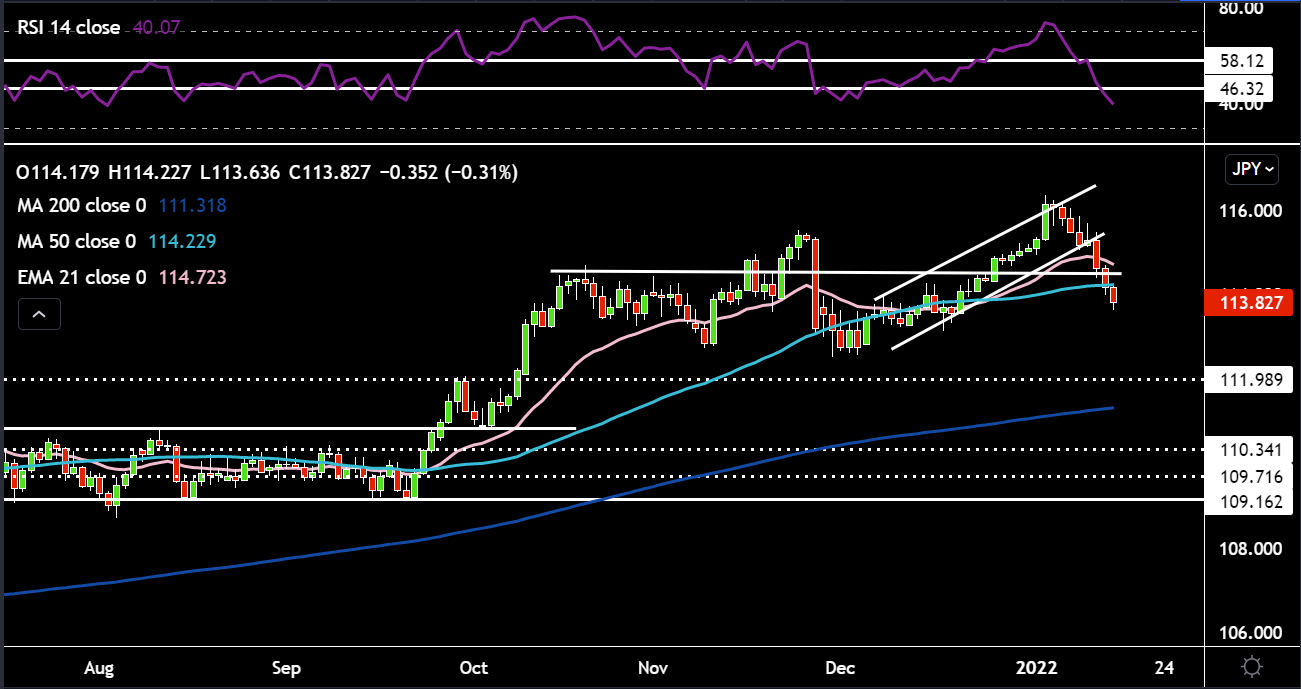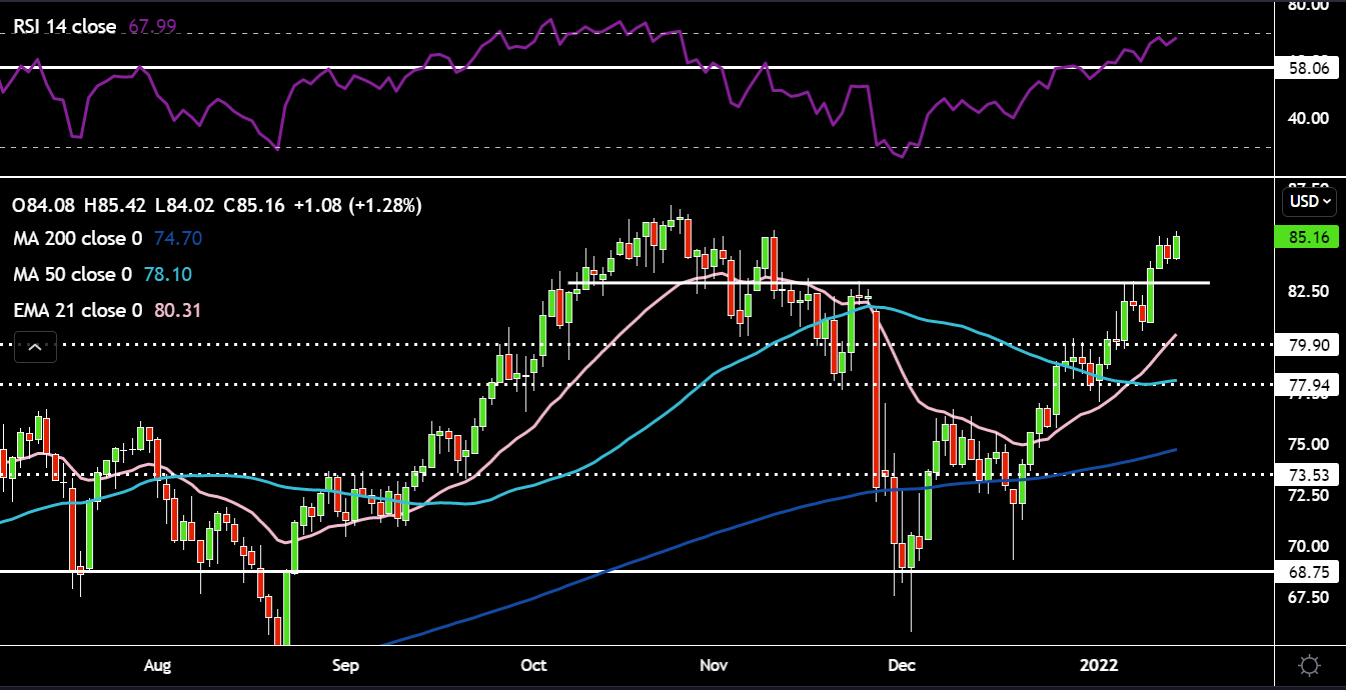CFDs are complex instruments and come with a high risk of losing money rapidly due to leverage. 72.2% of retail investor accounts lose money when trading CFDs with this provider. You should consider whether you understand how CFDs work and whether you can afford to take the high risk of losing your money.
- English
- Italiano
- Español
- Français
Dollar Index (DXY):
The dollar started the week off on the front foot as risk parity funds deleveraged due to the higher volatility in equity markets on the basis of liquidity continuing to be sucked out of markets. Then we saw a rebound in risk taking behaviour as Jerome Powell’s testimony was received dovishly by the market (can you say Turnaround Tuesday?). Also, when the hawkish Fed theme has become consensus it leaves little room for disappointment which is what we saw play out on Tuesday. This creates fertile ground for buy the rumour sell the fact dynamics to take place. This hypothesis seemed to play out on Wednesday too when the inflation print landed. 7 of the last 9 inflation drops have beaten estimates and Wednesday’s number of 7% headline inflation YoY, takes us all the way back to 1982 levels.
Looking for potential reasons as to why we saw the market reaction we did could be down to the decline in the MoM headline figure from the previous month, despite core coming in higher than the previous month. Additionally, the increase was isolated to a few factors as opposed to being more broad based, factors which price pressures are likely to dissipate. Supply chain stresses are expected to ease (zero covid policy in China could delay) and this could help with components such as used cars and then we have shelter/housing costs which should come under pressure as the Fed hikes and this feeds through to mortgage rates. Unfavourable high base effects will begin to take effect soon. Energy prices and a tight labour market still need to be monitored of course. Fed fund futures were practically unchanged, indicating the market is content with current hiking expectations. The dollar has continued its slide lower and is now through the 95 level which probably led to some CTA and momentum traders liquidating their positions. Jobless claims and PPI data out yesterday did little to move the dial with the big move already having taken place on Wednesday. The barrage of Fed hawkish speak and risk-off tone (sell-off in equity markets, VIX higher and AUDJPY lower) led to a small recovery in the dollar yesterday. Retail sales out later today is the final US economic print for the week.
(Source: TradingVIew - Past performance is not indicative of future performance.)
The dollar's slide through range support and the 50-day SMA has created some technical damage. It is now also below the 95 level and the lower trend line of the ascending channel. The RSI has fallen below the support from previous dips at 42 and is now nearing oversold territory. Targets wise, on the downside look towards 94.5 support and below there 94. On a reversal higher, the former range support as well as the 50-day SMA could make for good initial targets.
EURUSD:
The single currency is holding up well against the bearish consensus firmly entrenched in markets. Although you can add me to that list, the one risk to this view is a hawkish pivot by the ECB on stickier inflation and hawks overwhelming the doves (new Bundesbank President, Joachim Nagel, expressed his concerns about inflation risks and expressed the view that recent price pressures are not entirely due to temporary factors). A couple factors still provide me with enough confidence to expect further weakness in EURUSD 1) since GFC haven’t come close to 2% target 2) large output gap makes inflation unlikely to stick 3) economic fundamentals of economy aren’t strong enough 4) periphery bond markets debt levels and the widening spreads which would ensue. NATO's Chief Stoltenberg released a concerning statement mid-week that “there is a real risk for a new armed conflict in Europe”. This would likely come about from Russia invading Ukraine. Next week brings German ZEW survey results and eurozone consumer confidence data.

(Source: TradingVIew - Past performance is not indicative of future performance.)
EURUSD has broken out of its sideways congested price action and is now hovering in the mid-1.14s. The 21-day EMA is crossing above the 50-day SMA (positive short term signal). The RSI is nearing overbought territory. On the upside, the target looks to be 1.15 (horizontal resistance and upper trend line of the descending channel). On the downside, the former range resistance at 1.135 as well as the two moving averages would be a good level to watch.
GBPUSD:
Healthier risk sentiment, steeper 2s10s curve and a weaker dollar is allowing Cable to seriously outperform. With a quiet economic data calendar, domestic political news flow is now front and center. Boris Johnson is under severe pressure over allegations of his rule breaking party in May 2020. Betting markets’ odds are not in his favour and his performance at Wednesday’s PMQs wasn’t exceptional, essentially putting all his eggs into the findings of the formal investigation. The formal investigation should be released by the end of next week. Tories may wait until the local elections in May until they call for a leadership change. Despite this uncertainty, sterling crosses have not seen any of this negativity discounted, with the focus of FX traders probably more consumed by what the BoE does. It could also be due to Johnson’s potential replacement (Chancellor Sunak) being seen as a safe pair of hands. The latest YouGov poll shows Labour now has widened the gap with a 10% point leader over the Conservatives. Liz Truss met with Maros Sefcovic yesterday to continue discussions around Northern Ireland. Next week brings some key data for the UK with labour and inflation prints being released on Tuesday and Wednesday respectively. These two data points will be key to informing the BoE’s rate decision at their next meeting. Markets already see the probability of a hike in February at just over 80%.

(Source: TradingVIew - Past performance is not indicative of future performance.)
I definitely think some shorts are being squeezed here on cable. Price has practically gone up in a straight line and is now just above the 200-day SMA. The upper trend line of the descending channel has also been breached. The RSI is now in overbought territory. Think cable could be due a retracement soon. On the upside, 1.38 would be the score on the door and to the downside 1.37 would be of interest.
USDJPY:
Dollar yen has been on a one track direction South this week, tracking the decline in US 10-year yields, which failed to react to Wednesday’s US CPI numbers. Better risk sentiment is taking a back seat here in terms of drivers. Next week sees the Bank of Japan meeting. The factors to have on your radar should be the inflation forecasts and how that feeds through to market pricing as well as the BOJ’s commitment to yield curve control (YCC). I can’t see their inflation forecast coming close to 2% (necessary to prompt action on YCC), it will rise with the push higher in energy and the recent depreciation in the yen, but core drivers remain muted. Price has broken down through the mini ascending channel and is now below former range resistance at 114.5 and the 50-day SMA. The RSI has now breached the 46 support. Targets for this pair on the upside would be 115.5 (former high on November 21). On the downside, 113.5 would be the next key level.

(Source: TradingVIew - Past performance is not indicative of future performance.)
Gold:
Gold’s strong rebound this week can be explained quite simply by the reversal seen in real yields and then mid-week by the slump in the greenback given its inverse relationship with gold. Price is struggling at the key resistance level of $1830 as real yields picked up a bit yesterday. Another factor to monitor for gold would be activity with regards to Russia and Ukraine, with an escalation potentially seeing flows directed to the yellow metal. Gold is back running into resistance at the $1830 level - its arch nemesis. The RSI has petered out around the 62 resistance and turned downwards. If $1800 gives way then $1860 becomes the next target. On the downside, $1800 will be a key level of support and it coincides with all the moving averages.

(Source: TradingVIew - Past performance is not indicative of future performance.)
Crude Oil:
Crude stumbled as the week opened, however, that was clearly a temporary blip as price continues to rocket higher. In my mind, this strength is best explained by the improved risk sentiment, weaker dollar and a much larger than expected drawdown in US inventory levels. Furthermore, there is a growing chorus of countries now stating covid needs to be treated more like a flu, providing traders with a more optimistic demand picture moving forward. There also doubts that some OPEC+ members can deliver expected supply volumes.

(Source: TradingVIew - Past performance is not indicative of future performance.)
Oil has continued its charge higher, slicing through the key $83 level. The RSI is very close to the 70 zone. On the upside I'd look for moves towards the former high of $86.68 on October 25. On the downside, the former resistance at $83 would be key.
Ready to trade?
It's quick and easy to get started. Apply in minutes with our simple application process.
The material provided here has not been prepared in accordance with legal requirements designed to promote the independence of investment research and as such is considered to be a marketing communication. Whilst it is not subject to any prohibition on dealing ahead of the dissemination of investment research we will not seek to take any advantage before providing it to our clients. Pepperstone doesn’t represent that the material provided here is accurate, current or complete, and therefore shouldn’t be relied upon as such. The information, whether from a third party or not, isn’t to be considered as a recommendation; or an offer to buy or sell; or the solicitation of an offer to buy or sell any security, financial product or instrument; or to participate in any particular trading strategy. It does not take into account readers’ financial situation or investment objectives. We advise any readers of this content to seek their own advice. Without the approval of Pepperstone, reproduction or redistribution of this information isn’t permitted.
.jpg)